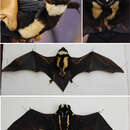Taxonomy
(
англиски
)
добавил EOL authors
Niumbaha Reeder et al., gen. n.
urn:lsid:zoobank.org:act:EDF16BEE-0749-41BC-AE19-BAE130BE58F8
http://species-id.net/wiki/Niumbaha
Etymology. The name is the Zande word for ‘rare/unusual’. This name was chosen because of the rarity of capture for this genus, despite its wide distribution throughout West and Central Africa, and for the unusual and striking appearance of this bat. Zande is the language of the Azande people, who are the primary ethnic group in Western Equatoria State in South Sudan (where our recent specimen was collected). The homeland of the Azande extends westwards into Democratic Republic of the Congo, where superba has also been collected (the holotype and another recent capture), and into southeastern Central African Republic. Gender: feminine.
Type species.. Glauconycterissuperba Hayman, 1939; by monotypy.
- лиценца
- cc-by-3.0
- авторски права
- DeeAnn M. Reeder, Kristofer M. Helgen, Megan E. Vodzak, Darrin P. Lunde, Imran Ejotre
- библиографски навод
- Reeder D, Helgen K, Vodzak M, Lunde D, Ejotre I (2013) A new genus for a rare African vespertilionid bat: insights from South Sudan ZooKeys 285: 89–115
- автор
- Katja Schulz (Katja)
Distribution
(
англиски
)
добавил Zookeys
Niumbaha superba has been rarely captured (only five times) but is apparently widely distributed (Fig. 7), being recorded from Ghana, Ivory Coast, Democratic Republic of the Congo and South Sudan. This broad distribution suggests that it is more common than its collection records indicate. Although most species in its apparent sister genus, Glauconycteris,are not well known, at least one species (Glauconycteris variegata) is believed to be a high flier (Obrist et al. 1989), which could translate to poor capture success for Niumbaha, especially if it typically flies at even greater heights. Glauconycteris are found in a variety of habitats, mostly from moist forest zones (Rosevear 1965). We can only speculate that Niumbaha is found in similar habitat types. Neither the description of the first specimen collected in the Democratic Republic of Congo (Hayman 1939) nor that of the second specimen from Ghana, which was “found alive on the ground” (Hayman 1947:550) contain habitat descriptions. However, Rosevear (1965) noted that both locations were in closed forest (though the Ghana location was on the edge of closed forest and a Guinea woodland zone) and Hayman and Hill (1971) noted that both locations are from heavy rain forest. A recent specimen from Democratic Republic of the Congo was mist-net captured in secondary forest (Gembu Tungaluna 2012) and our specimen from South Sudan was mist-net captured on a grassland plateau just above a secondary thicket forest.
- лиценца
- cc-by-3.0
- авторски права
- DeeAnn M. Reeder, Kristofer M. Helgen, Megan E. Vodzak, Darrin P. Lunde, Imran Ejotre
- библиографски навод
- Reeder D, Helgen K, Vodzak M, Lunde D, Ejotre I (2013) A new genus for a rare African vespertilionid bat: insights from South Sudan ZooKeys 285: 89–115
- автор
- DeeAnn M. Reeder
- автор
- Kristofer M. Helgen
- автор
- Megan E. Vodzak
- автор
- Darrin P. Lunde
- автор
- Imran Ejotre

